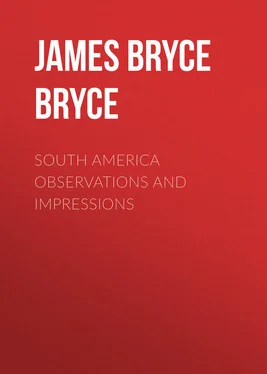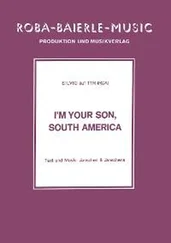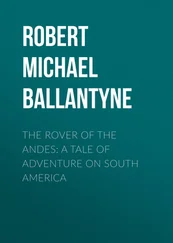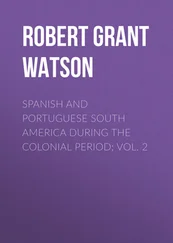James Bryce Bryce - South America Observations and Impressions
Здесь есть возможность читать онлайн «James Bryce Bryce - South America Observations and Impressions» — ознакомительный отрывок электронной книги совершенно бесплатно, а после прочтения отрывка купить полную версию. В некоторых случаях можно слушать аудио, скачать через торрент в формате fb2 и присутствует краткое содержание. Жанр: foreign_antique, foreign_prose, на английском языке. Описание произведения, (предисловие) а так же отзывы посетителей доступны на портале библиотеки ЛибКат.
- Название:South America Observations and Impressions
- Автор:
- Жанр:
- Год:неизвестен
- ISBN:нет данных
- Рейтинг книги:3 / 5. Голосов: 1
-
Избранное:Добавить в избранное
- Отзывы:
-
Ваша оценка:
- 60
- 1
- 2
- 3
- 4
- 5
South America Observations and Impressions: краткое содержание, описание и аннотация
Предлагаем к чтению аннотацию, описание, краткое содержание или предисловие (зависит от того, что написал сам автор книги «South America Observations and Impressions»). Если вы не нашли необходимую информацию о книге — напишите в комментариях, мы постараемся отыскать её.
South America Observations and Impressions — читать онлайн ознакомительный отрывок
Ниже представлен текст книги, разбитый по страницам. Система сохранения места последней прочитанной страницы, позволяет с удобством читать онлайн бесплатно книгу «South America Observations and Impressions», без необходимости каждый раз заново искать на чём Вы остановились. Поставьте закладку, и сможете в любой момент перейти на страницу, на которой закончили чтение.
Интервал:
Закладка:
Gazing from the deck hour after hour on this dreary coast, and remembering that the Atlantic side of the Continent in the same latitude is one of the best watered and richest parts of the tropics, one is struck by the unfortunate physical conditions that make useless a region whose climate, kept so cool by the Antarctic current would otherwise have fitted it for the development of progressive communities. Such communities did exist among the subjects of the Chimu, but being confined to a few valleys, they were not strong enough to resist the impact of the more numerous mountain tribes. Thus it was only on the plateau behind that a great nation could grow up. With a moderate rainfall these six hundred miles of coast might have been one of the most fertile parts of South America, and the history of Peru would have been altogether different. The absence of rain has provided a compensation in the form of a product which, though it cannot be used on the spot, became serviceable to other countries, and might have given Peru the means of developing mines or building railroads. The droppings of the swarms of sea-birds that frequent the rocky islands along the coast instead of being, as in other countries, washed away by showers, have accumulated till they formed those huge masses of guano which eighty years ago began to be carried away and sold to European countries as the most efficient fertilizers. The Inca sovereigns knew their value and are said to have protected the birds. Unfortunately, this easily obtained source of national wealth excited the cupidity of revolutionary leaders, each of whom fought for power because power meant the command of the revenue derivable from these deposits. Not much is now left, and the republic has been none the better for them. Some of the largest were on the Chincha Islands. The islets are all bare, some shewing bold lines and sharp peaks which remind one of those that fringe the coast of Norway about the Arctic circle.
The entrance to Callao, the port of the city of Lima, which lies seven miles inland and is five hundred feet higher, has a certain grandeur. A range of hills abuts on the sea, forming a bold cape, and opposite to it, leaving an entrance a mile or two wide, rises a lofty island, steep, bare and brown like the islands of the Red Sea, which reduces the long surges of the Pacific and gives a comparatively quiet anchorage in the spacious bay within. The town of Callao, consisting of steamship offices and warehouses and shops dealing in the things ships need, offers nothing of interest, except the remains of the fort of St. Philip, the last building where the flag of Spain floated on the mainland of the New World. So the traveller hurries by the steam railroad or the electric line up to Lima.
We came full of the expectations stirred long ago by the fame of the city Pizarro built, and in which he ruled and perished, hoping to find in it another and a still more picturesque and more truly Spanish Mexico. It was long the first city of South America, into which the silver mines poured fabulous wealth. Its Viceroy was the greatest man in the Continent, a potentate whose distant master could seldom interfere with him, for there were no telegraphs or steam vessels in those days. Nobody but the archbishop could oppose him; nor need he fear anybody but the head of the Inquisition and the head of the Jesuits. The pomp that surrounded him, the pageants with which his entrance was celebrated, were like those of a Mogul Emperor.
Lima was called by Pizarro the City of the Kings, i. e. the Three Wise Men of the East, but the name it now bears, a variant from that of the river Rimac, soon prevailed. It stands in a wide flat valley, guarded by steep mountains to the north, on both banks of the broad stony bed of the Rimac, a large part of whose waters has been diverted for irrigation. Except where this river water has made cultivation possible, the plain is bare, being part of the coastal desert. The high range of hills already mentioned guards the city on the north, and runs out to the sea on the northwest. Lofty spurs of the Andes are visible to the east, but for much of the year the clouds hang so low that the hills are hardly part of the landscape and the great peaks are seldom seen.
As in most Spanish-American cities, the streets are narrow and straight, cutting one another at right angles. One is at first surprised to find the houses extremely low, many of one story and hardly any (save a few new residences on the outskirts) exceeding two stories, and to be told that they are built of bricks, or more commonly of cane and reeds plastered with mud. It is commonly said that in Lima a burglar needs nothing more than a bowl of water and a sponge to soften the plaster, and a knife to cut the canes. But the reason is apparent when one remembers that no place on the West coast has suffered more from earthquakes. Thus, except the convents and some of the older churches, everything looks modern, unsubstantial, and also unpicturesque, having little variety and little ornament in the architecture except the long wooden balcony which usually projects above the gateway. The bridge that spans the Rimac is hardly worthy of a great capital. The shops are small and mediocre, and only in one or two thoroughfares is there any throng of passers to and fro. One notes little of the life and stir, and still less of the stateliness, that befits an ancient and famous home of power.
Yet to this mediocrity there is one exception. It is the great central square. In a Spanish, as in an Italian, city, one usually enquires first for the Square, for whatever nobleness a place has is sure to be there. The Plaza de Armas at Lima has much dignity in its ample space, and beauty in its fine proportions, in its central fountain, in the palms and flowering trees and statues which adorn it, besides a wealth of historic associations in the buildings that stand around it. Most conspicuous is the Cathedral, with its rich façade, its two quaint towers, its spacious interior, not broken, as are most of the great churches of Old Spain, by a central choir, its handsome carved choir stalls, its side chapel shrines, in one of which a glass case holds bones which tradition declares to be those of the terrible Pizarro. That pious conqueror founded the church in 1540, but earthquakes have made such havoc with the walls that what one sees now is of much later date. At the opposite corner of the Plaza are the government offices, comparatively recent buildings, low, and of no architectural interest. In the open arcade which borders them a white marble slab in the pavement marks the spot where Pizarro, cut down by the swords of his enemies, the men of Chile, made the sign of the cross with his own blood as he expired. The passage is still shown whence the assassins emerged from a house hard by the Cathedral, where they had been drinking together to nerve themselves, and crossed the Plaza to attack him in his palace. Also on the Plaza, facing the Cathedral, is the municipal building, from the gallery of which, nearly three centuries after the Inca power had fallen under the assault of Pizarro, General San Martin, the heroic Argentine who led the revolutionary forces to the liberation of Peru, proclaimed to the crowd beneath the end of Spanish rule in South America. Of the old Palace of the Viceroys, which also fronted on the Plaza, there remains only the chapel, now desecrated and used as a storehouse for archives, whose handsome ceiling and walls, decorated with coloured tiles of the sixteenth century, carry one back to the Moorish art of Spain. Other churches there are in plenty, – seventy-two used to be enumerated, – and some of them are large and grandiose in style, but all are of the same type, and none either beautiful or imposing.
Few relics of antiquity are left in them or indeed anywhere in Lima. The library of the University, the oldest seat of learning in America, which was formerly controlled and staffed by the Society of Jesus, suffered sadly at the hands of the Chilean invaders when they took the city in the war of 1882. The old hall of the Inquisition, in which the Peruvian Senate now sits, has a beautiful ceiling of dark red cedar richly carved, a work worthy of the best days of Spain. What scenes may it not have looked down upon during the three centuries when the Holy Office was a power at the name of which the stoutest heart in Lima trembled! And out of the many fine old mansions of colonial days one has been preserved intact, with a beautiful gallery running along its four sides of a spacious patio (internal court), and in front a long-windowed, richly decorated balcony, a gem of the domestic architecture of the seventeenth century, perhaps the most perfect, that earthquakes, fire, and war have permitted to survive in Spanish America. There is so little else to remember with pleasure from the days of the Viceroys and the Inquisitors that these relics of expiring artistic skill may be valued all the more.
Читать дальшеИнтервал:
Закладка:
Похожие книги на «South America Observations and Impressions»
Представляем Вашему вниманию похожие книги на «South America Observations and Impressions» списком для выбора. Мы отобрали схожую по названию и смыслу литературу в надежде предоставить читателям больше вариантов отыскать новые, интересные, ещё непрочитанные произведения.
Обсуждение, отзывы о книге «South America Observations and Impressions» и просто собственные мнения читателей. Оставьте ваши комментарии, напишите, что Вы думаете о произведении, его смысле или главных героях. Укажите что конкретно понравилось, а что нет, и почему Вы так считаете.












